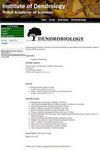Contrasting foliar and soil nutrients responses to drought induced crown dieback in a Quercus brantii forest
IF 1.8
4区 农林科学
Q2 FORESTRY
引用次数: 1
Abstract
Evidence has shown that drought-induced crown dieback has significant interaction with soil-plant water and nutrients relationships, but there isn’t sufficient knowledge of the water and nutrients connections in declining Persian oak (Quercus brantii) trees. To investigate the relationships between crown dieback and leaf nutrients concentrations, leaf water content, soil nutrients concentrations and soil moisture, one of the dieback affected stands was selected. This stand was located in Shalam forested area in northern Ilam province, west of Iran. Persian oak trees were evaluated using a crown dieback classification and divided into four classes with four replicates based on the severity of crown dieback. Sampling from leaves of trees and soil was implemented randomly in four sides of tree crown in August. Trees with moderate to severe declining showed reduced leaf water content (WC) and reduced relative leaf water content (RWC). Leaf N and P concentration of declining trees was significantly (p-value <0.05) more than that of healthy trees. The leaf K concentration of declining trees was significantly (p-value <0.10) more than that of the healthy. The leaf N:P amounts of oak trees was statistically different among crown dieback classes. But no significant differences was observed between the healthy and declining trees in terms of soil N, P, K, Ca and Mg concentrations and soil moisture. It was concluded that drought has effects on the nutrients status in the leaves of Persian oak trees and their changing in the declining trees is for resistance to drought condition, improving water use efficiency and possibly performance of vital activities.白栎林叶片和土壤养分对干旱枯死的响应对比
有证据表明,干旱引起的树冠枯死与土壤-植物的水分和养分关系有显著的相互作用,但对衰退的波斯栎(Quercus brantii)树的水分和营养关系知之甚少。为了研究树冠枯死与叶片养分浓度、叶片含水量、土壤养分浓度和土壤湿度之间的关系,选择了一个受枯死影响的林分。该林分位于伊朗西部伊拉姆省北部的Shalam森林地区。采用树冠枯死分类法对波斯橡树进行了评估,并根据树冠枯死的严重程度将其分为四类,四个重复。8月,在树冠的四个侧面随机抽取树叶和土壤。中度至重度衰退的树木表现出叶片含水量(WC)降低和相对叶含水量(RWC)降低。衰退树木的叶片N和P浓度显著高于健康树木(P值<0.05)。衰退树的叶片K浓度显著高于健康树(p值<0.10)。不同树冠枯死类别的橡树叶片氮磷含量存在统计学差异。但在土壤N、P、K、Ca、Mg浓度和土壤水分方面,健康树和衰退树之间没有显著差异。结果表明,干旱对波斯橡树叶片的营养状况有影响,其在衰退期的变化是为了抵抗干旱,提高水分利用效率,并可能表现出重要的生命活动。
本文章由计算机程序翻译,如有差异,请以英文原文为准。
求助全文
约1分钟内获得全文
求助全文
来源期刊

Dendrobiology
农林科学-林学
CiteScore
2.20
自引率
11.10%
发文量
17
审稿时长
>12 weeks
期刊介绍:
Dendrobiology publishes original research articles and review articles related to the biology of trees and shrubs.
 求助内容:
求助内容: 应助结果提醒方式:
应助结果提醒方式:


